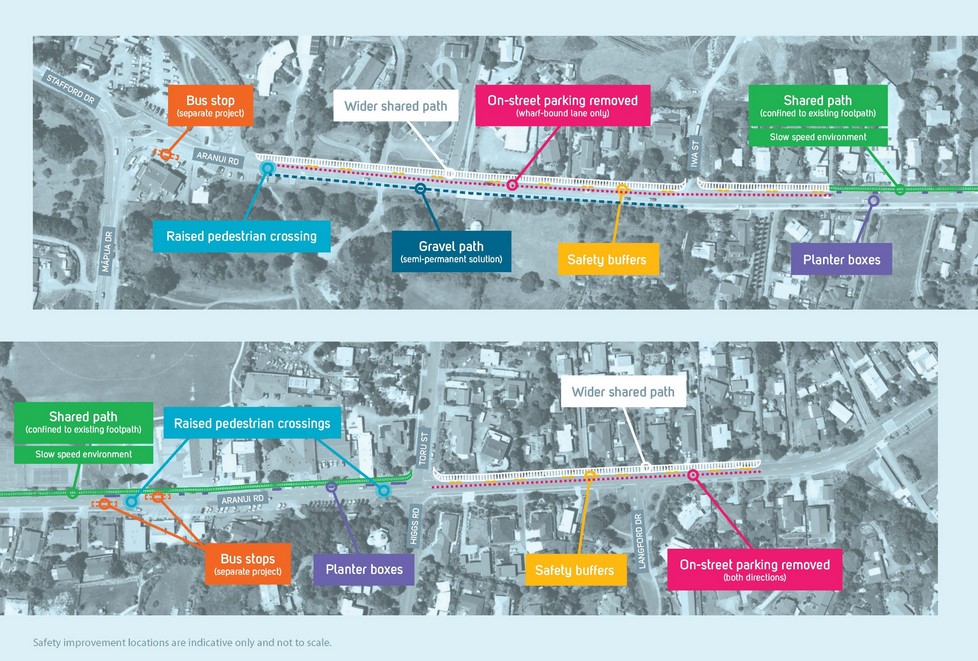Feedback gathered on Māpua’s fraught Streets for People project


Māpua's Streets for People project has seen planter boxes, cycleways and raised pedestrian crossings added to the main street. Photo: Supplied/TDC.
Community feedback is being sought following the implementation of Māpua’s contentious Streets for People project, which has seen planter boxes, cycleways and raised pedestrian crossings added to the main street.
In the two weeks that the Tasman District Council’s online survey has been open, more than 400 responses have been received, with a further 10 weeks for residents to trial and make comment on the changes.
The Waka Kotahi-funded project has proved controversial, with some residents voicing strong opposition to both the changes that have been made and the processes that were used to make them.
However, council representatives are urging people to view the elements of the Streets for People pilot project as flexible, with adaptions possible after first-hand feedback has been shaped by their “experiential engagement”.
On the Streets for People website, it states that the key point of the project is that it utilises materials that can be repurposed.
“This means once the new layout is down, and we find it needs tweaking, we have the flexibility to do that simply and efficiently.”
About a fortnight ago, a dozen Māpua locals gathered together to share their concerns, with one resident, who did not wish to be named, dubbing the project “taking streets from the people”.
Lynley Worsley, who has lived in the village for more than 20 years, says that if the changes had stopped at the new path that headed towards Stafford Drive, and the two raised pedestrian crossings, “that would have solved almost every issue that we have.”
“It’s just not more user-friendly. It’s just not.”
Fellow resident Marion Satherley says, she felt that the addition of a combined walkway and cycleway was “just a disaster”, with the council missing “a golden opportunity to separate cyclists and pedestrians”.
Val Hunter, who often uses a walker frame and mobility scooter to move around the village, says that she now tried to stay at home after 2.30pm, when the walkways became too hazardous for her to navigate.
However, TDC transportation manager Jamie McPherson says that the constraints of the available road width meant there was not the space, or the budget, to create a separated cycleway in each direction.
“The shared path configuration is something that will be reviewed following the feedback process, so an alternative configuration of the space is certainly a possibility.”
He also acknowledged that some people have been more negatively impacted than others by the removal of almost 100 car parks along Aranui Rd.
“We do review the feedback and have been in contact with some of those on a case-by-case basis.”
He says that the carpark occupancy rates are surveyed each summer, and the most recent survey from 2022/2023 showed that “most of the time there are a large number of spare carparks available all around Māpua”.
Another sticking point for the community has been the addition of planter boxes along Aranui Rd, which were intended to give clear sight distances for those using the new crossings, as well as visually narrowing the road to help slow vehicles, and introducing more greenery.
Residents have scorned the boxes, labelling them as unsightly and unsafe, as they make it harder to navigate the road. They also spoke about how the boxes were not in keeping with the “special character” of the Māpua village.
Jamie reminded residents that the Streets for People changes, including the planter boxes, are interim measures to help define a more permanent solution.
“The planter boxes won’t be there forever,” he says.
“They are about testing a concept of where more garden or trees could be used in future. The idea is that they could be replaced by something more permanent and in keeping with the village character.”
Another council representative confirmed that the planter boxes were “a temporary example of what could be put in place once a more permanent solution can be established and funded”.
These solutions could be kerb build-outs or garden areas, he says.
When asked how quickly those changes might happen after the survey closed, he said that it could be a couple of months or longer.
“It’s more about finding the dollars.”
